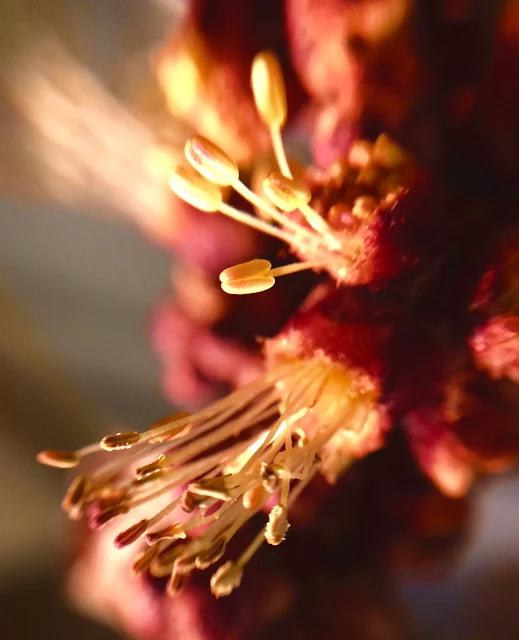What's Blooming (in order of appearance) : snowdrops, Maple trees, daffodils, crocus & common violets; boxwoods, Japanese andromeda and yew, hellebore, winter heath, forsythia, hyacinth, Callery pear trees, Cherry trees, Magnolias, eastern redbud, dogwood, azalea, rhododendron, afterwards "it's just green*"
Here's what's blooming in northern Virginia or, as the locals call it, NoVA.
 |
March 11: I quite like how daffodils look interplanted with pachysandra.
|
 |
| March 12: Overhead, maples explode into bloom. A good source of both nectar and pollen, this is the wax flow for strong overwintered colonies. |
The solstice is when the queen begins laying again, so I thought I's start planning for the year ahead. I always start my beekeeping calendar with December. 2020 Averages were: 53°F hi / 30°lo; Precip 6.3" (above ave) with 1" being snow. No arctic cold like we had in Colorado 😊 but 2020 was way wetter than normal and it snows here. Winter hardy pansies bloom unfazed but there are no flying days, for sure.
The coldest day of the year occurs in January. 2021 Avg Temperatures 42 hi / 27 lo ; Precip 1.6" (above ave). In Colorado, currently enjoying 2 feet of snow as I write, there'd invariably be a 60° day to sneak a peak and check on food stores. Here the weather isn't schizophrenic; it doesn't snow as much but once it gets cold it just stays cold. (And once it warms up, it just stays warm.) Another thing I've noticed is the wind. In Colorado, we'd have wind
events. Big, blow-the-fences-over events every so often. Here, so close to the coast, the winter winds are mostly
constant or gusty. Layered with the hum of air traffic from Dulles, I'm not a fan. Bottom line, there's no opening a hive to pop in emergency feed so you better have winterized properly back in the Fall.
February: 2021 Avg Temperatures 48 hi / 27 lo ; Precip 3.7" (above ave) with 1" being snow (booo). I haven't seen a honeybee since November and can't tell if I'm depressed from the lingering gloomy weather or the lingering global pandemic.
March. Quite abruptly, Spring begins to assert itself, announced by the chorus of peepers and wood frogs. The ground must finally be thawed! Flowering bulbs, Japanese andromeda, and maples of all sorts have burst into bloom. Great for the bees but my allergies are out of control! With each Puffs, I'm reminded why we left the east coast in the first place. 🤔 As with CO, I think this is when colonies die from starvation. Growing population and diminishing food stores aside, it's isolation starvation I'd worry about most. Unlike CO, there's no solar gain for the bees to break cluster and move about during cold spells. The stable weather is gray mixed with mostly cloudy, and it's still going below freezing overnight. Flying days do occur, though. There are beehives not far from us, 10 in the bottom photo, and there's definitely some orientation flying.
 |
| March 19: Snow crocuses parade across the lawns. |
|
|
|
|
 |
March 20: Anubis among hellebores at Lake Anne.
|
 |
March 27: Forsythia and Andromeda. Yeah, they bloom together but personally I wouldn't plant them together. Frankly, the landscape design around here leaves much to be desired.
|
 |
Even the road absolutely lined with Callery Pears can't compete with the showstopping 'Royal Star' magnolia. Its pristine white floppy petals flutter in the slightest breeze to catch and hold your attention.
|
Projecting Forward (because a large part of a beekeeper's job is anticipating their bees' needs):
April: 🌸🌸🌸🌸🌸🌸🌸 Oh, how I want to hop across the river into DC to see the Cherry blossoms, but the barricades from the capitol insurrection are still up. Based on this article by George Imirie, Retard Swarming By Making A Split, I'm guessing April will be the ideal time to acquire local bees from someone doing a preventive split. It'll have to be a shook swarm unless we can find a local top bar beekeeper. Doesn't matter what part of the country you're in, that's a hurdle. I'll post any VA TBH resource I find for you ASAP.
A full month ahead of Colorado, April into early May is SWARM SEASON, again based on Mr. Imirie's knowledgebase, so it could be a good time to re-stock the hives.
 |
About a mile into the Pipeline Trail there is a house with 10 beehives and another with 7, including 2 nucs. We haven't met their beekeepers yet, but it's only mid-March and it looks like they're doing splits already!
|
Additional Resources: https://www.jmu.edu/arboretum/whats-in-bloom/whats-in-bloom.shtml
https://carroll.ext.vt.edu/content/dam/carroll_ext_vt_edu/beekeepers_year_va_apiary.pdf
https://buzzwordhoney.com/wp-content/uploads/2012/12/Northern-Virginia-Honeybee-Annual-Cycle.pdf
Weather almanacs: www.wunderground.com/history/monthly/us/va/chantilly/KIAD/date/2020-12
* the Channel 5 weather guy said it, and it makes me sad.




























